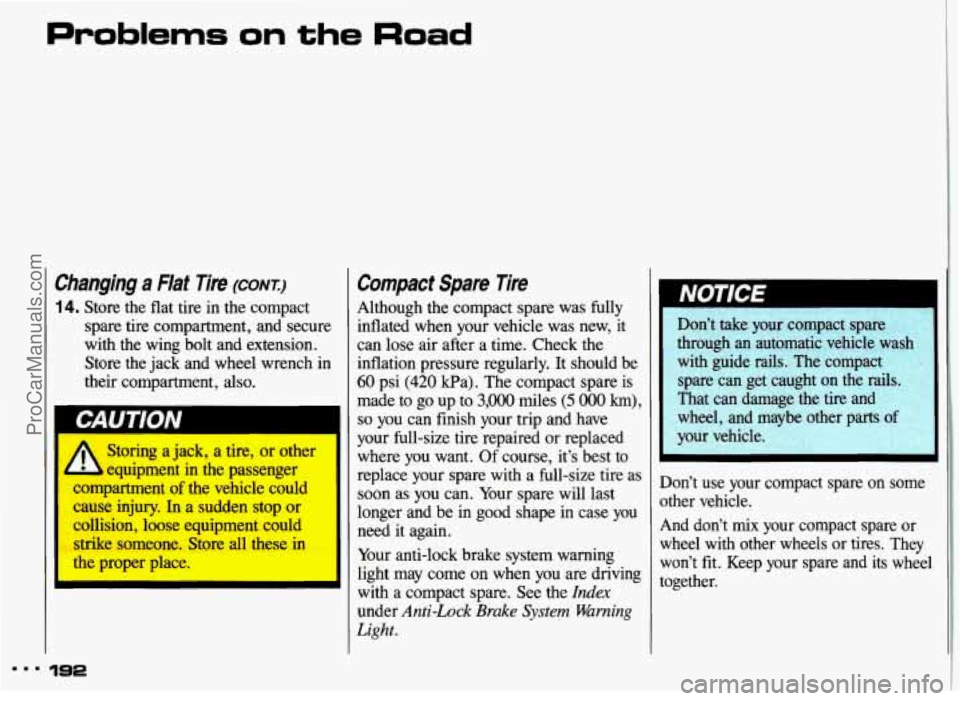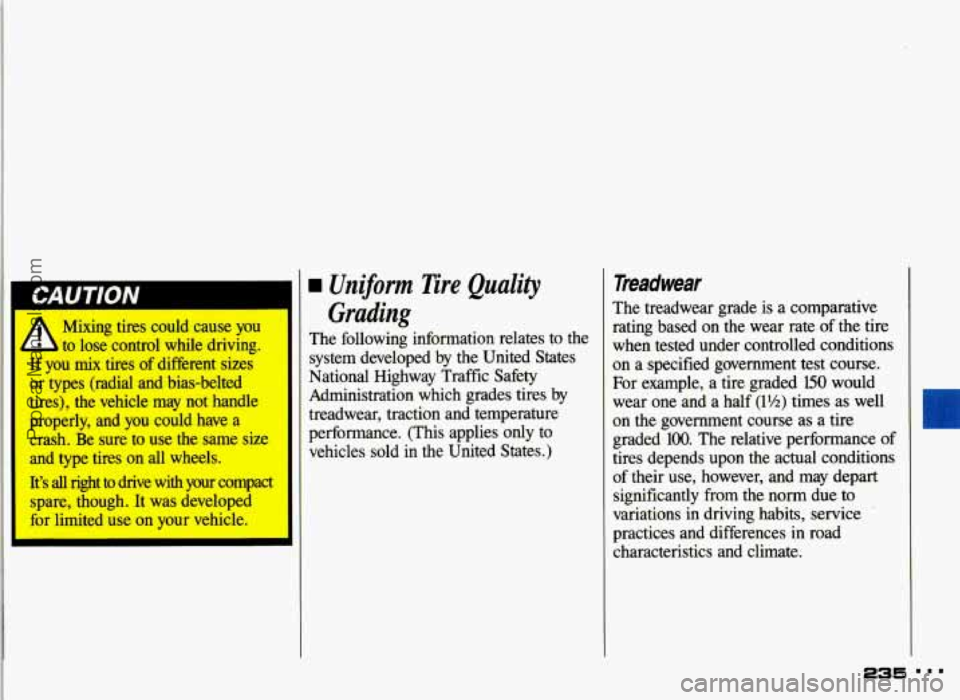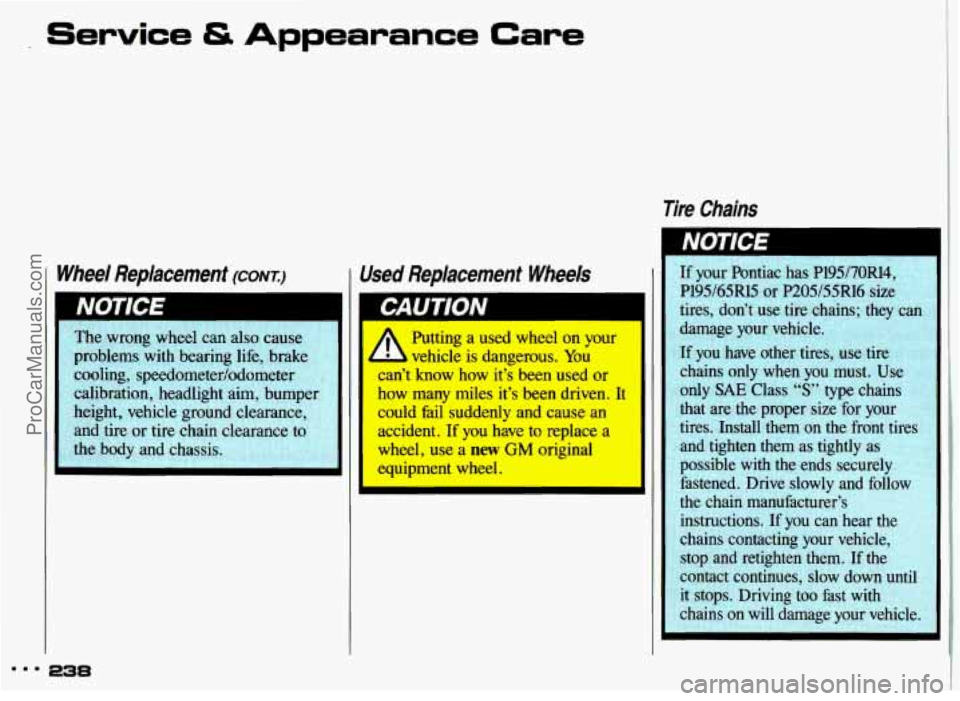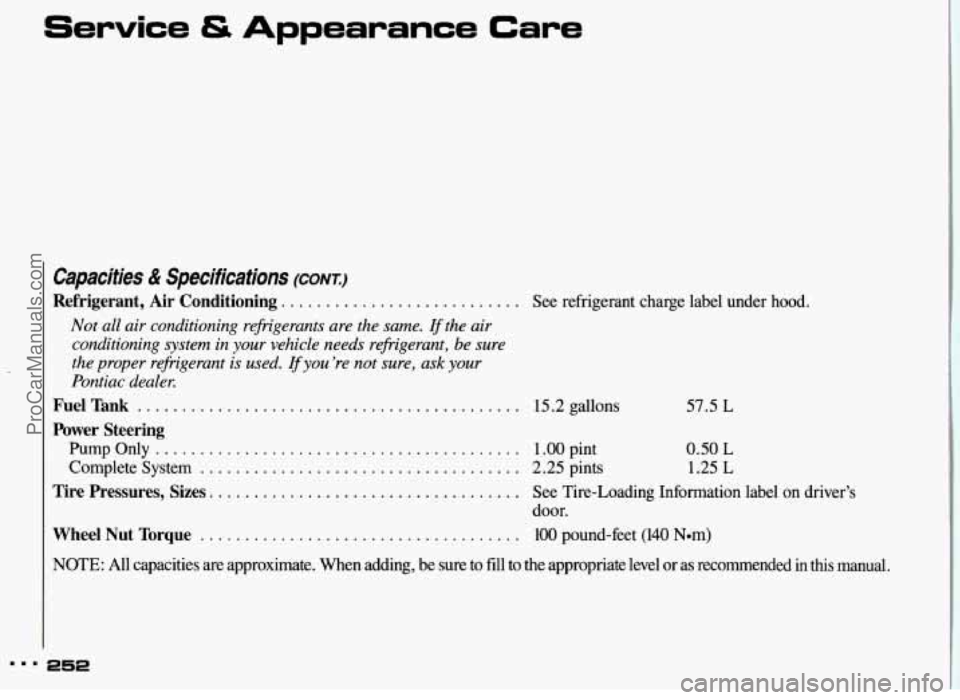1993 PONTIAC GRAND-AM tire size
[x] Cancel search: tire sizePage 193 of 306

Changing a Flat Tire (corvr)
14. Store the flat tire in the compact
spare
tire compartment, and secure
with the
wing bolt and extension.
Store the jack and wheel wrench in
their compartment, also.
I A Storing a jack, a tire, or other
- equipment in the passenger
ompartment
of the vehicle could I
cause injury. In a sudden stop or
collision, loose equipment could strike someone. Store all these in
the proper place.
i
Compact Spare Tire
Although the compact spare was fully
inflated when your vehicle was new, it can lose air after a time. Check the
inflation pressure regularly. It should be
60 psi (420 Wa). The compact spare is
made to go up to
3,000 miles (5 O00 km),
so you can finish your trip and have
your full-size tire repaired or replaced
where you want.
Of course, it’s best to
replace your spare with a full-size tire as
soon
as you can. Your spare will last
longer and be in good shape
in case you
need it again.
Your anti-lock brake system warning
light may come on when you are driving
with a compact spare. See the
Idex
under Anti-Lock Brake System Warning
Light.
192
Don’t take your compact spare
through
an automatic vehicle wash I
with guide rails. The compact spare can get caught on the rails.
That can damage the tire and
wheel, and maybe other parts
of
your vehicle.
)on? use your compact spare on some
)ther vehicle.
ind don’t
mix your compact spare or
vheel with other wheels or tires. They
von’t
fit. Keep your spare and its wheel
ogether.
ProCarManuals.com
Page 231 of 306

Service & Appearance Care
Windshield Wiper Blade
Replacement
Replacement blades come in different
types and are removed in different ways.
Here’s how to remove the type with a
release clip:
1 . Pull the windshield wiper arm away
2. Lift the release clip with a
from the windshield.
screwdriver and pull the blade
assembly off the wiper arm.
the wiper arm.
3. Push the new wiper blade securely on
Loading bur Vehicle
Two labels on your vehicle show how
much weight it may properly carry. The
Tire-Loading Information label found on
the rear edge of the driver’s door tells
you the proper size, speed rating and recommended inflation pressures for the
tires on your vehicle. It also gives
you
important information about the number
of people that can be in your vehicle and
the total weight that you can carry. This
weight is called the Vehicle Capacity
Weight and includes the weight of all
occupants, cargo, and all nonfactory- installed options. The other label is the Certification
sticker, also on the rear edge of the
driver’s door. It
tells you the gross
weight capacity of your vehicle, called
the GVWR (Gross Vehicle Weight
Rating). The GVWR includes the
weight of the vehicle, all occupants, fuel
and cargo. Never exceed the GVWR for
your vehicle, or the Gross Axle Weight Rating (GAWR) for either the front or
rear axle.
And, if you do have a heavy load, you
should spread it out. Don’t carry more
than
132 lbs. (60 kg) in your trunk.
ProCarManuals.com
Page 235 of 306

Service & Appearance Care
Tire Inspection and Rotation
(CONT)
1 Rust or dirt on a wheel, or on
- b the. parts to which it is
htened, ean fnake wheel nuts I
become loose after a time, The
wheel could come off and cause an I accident. When you change a
wheel, remove any rust or dirt
from plks where the wheel
When lt’s Time for New Tires
One way to tell when it’s time for new
tires is to check the treadwear
indicators, which will appear when your
tires have only
2/32 inch (1.6 mm) or
less of tread remaining.
You need a new tire if:
You can see the indicators at three
You can see cord or fabric showing
The tread or sidewall is cracked. cut.
places around the tire.
through the tire’s rubber.
attaches to the vehicle. ~n an 7 -
emergency, you can use a cloth or I I or snagged deep enough to show cord
a ppr towel ta do this; but be or fabric.
sure t.a use a scraper or wire brush The tire has a bump, bulge or split.
later, if you need to, to get all the The tire has a puncture, cut, or other
rust or dirt off, (See the Index damage that can’t be repaired well
undkr hgiing a 2?i?af Ere.) because of the size or location of the
I damage.
... 234
Buying New Tires
To find out what kind and size of tires
you need, look at the Tire-Loading
Information label.
The tires installed on your vehicle when
it was new had a Tire Performance
Criteria Specification (TPC Spec)
number on each tire’s sidewall. When
you get new tires, get ones with that
same TPC Spec number. That way, your
vehicle will continue to have tires that
are designed to give proper endurance,
handling, speed rating, traction, ride and other things during normal service
on your vehicle.
If your tires have an all-
season tread design, the TPC number
will be followed by a
“MS” (for mud
and snow).
If you ever replace your tires with those
not having a TPC Spec number, make
sure they are the same size, load range,
speed rating and construction type (bias,
bias-belted
or radial) as your original
I tires.
ProCarManuals.com
Page 236 of 306

CAUTION
A
Mixing tires could cause you
to lose control while driving.
If you mix tires of different sizes
or types (radial and bias-belted
tires), the vehicle may not handle
properly, and you could have a
crash. Be sure to use the same size
and type tires on all wheels.
It's
all right to drive with your compact
spare, though. It was developed
for limited use
on your vehicle.
I
Grding
The following information relates to the
system developed by the United States
National Highway Traffic Safety
Administration which grades tires by
treadwear, traction and temperature
performance. (This applies only to vehicles sold in the United States.)
Treadwear
The treadwear grade is a comparative
rating based on the wear rate of the tire
when tested under controlled conditions
on a specified government test course.
For example, a tire graded
150 would
wear one and a half
(1%) times as well
on the government course as a tire
graded
100. The relative performance of
tires depends upon the actual conditions of their use, however, and may depart
significantly from the norm due to
variations in driving habits, service
practices and differences in road
characteristics and climate.
235 " '
ProCarManuals.com
Page 239 of 306

Service & Appearance Care
Tire Chains
...
Wheel Replacement (CONT.)
The wrong wheel can also cause
problems with bearing life, brake cooling, speedometer/odometer
calibration, headlight aim, bumper
height, vehicle ground clearance,
and tire or tire chain clearance to
the body and chassis.
I
238
Used Replacement Wheels
Putting a used wheel on your
L vehicle is dangerous. You
I cs know how it’s been used or
how many miles it’s been driven. It
-mid fail suddenly and cause an
accident. If you have
to replace a
\wheel, use a
new GM original If your Pontiac has P195/70R14,
P195/65R15
or P205/55R16 size
tires, don’t use tire chains; they can
damage your vehicle.
If you have other tires, use tire
chains only when you must. Use
only
SAE Class “S” type chains
that are
the proper size for your
tires. Install them
on the front tires
and tighten them as tightly as
possible with the ends securely fastened. Drive slowlv and follow
r’
the chain manufacturer’s
instructions. If you can
h
chains contacting your v
stop and retighten them. If the
contact continues, slow down until
it stops. Driving too fast with
chains on will damage your vehicle.
ProCarManuals.com
Page 253 of 306

Service & Appearance Care
Capacities & Specifications (CONT.:)
Refrigerant, Air Conditioning. .......................... See refrigerant charge label under hood.
Not all air conditioning refrigerants are the same. If the air
conditioning system in
your vehicle needs refngerant, be sure
the proper refrigerant is used.
If you’re not sure, ask your
Pontiac dealer.
Fuel Tank ......................................... 15.2 gallons 57.5 L
Power Steering
Pump Only ......................................... 1 .OO pint 0.50 L
Complete System .................................... 2.25 pints 1.25 L
Tire Pressures, Sizes. .................................. See Tire-Loading Information label on driver’s
Wheel Nut Torque .................................... 100 pound-feet (140 Nom)
door.
NOTE: All capacities are approximate. When adding, be sure to fill to the appropriate l\
evel or as recommended in
this manual.
... 252
ProCarManuals.com